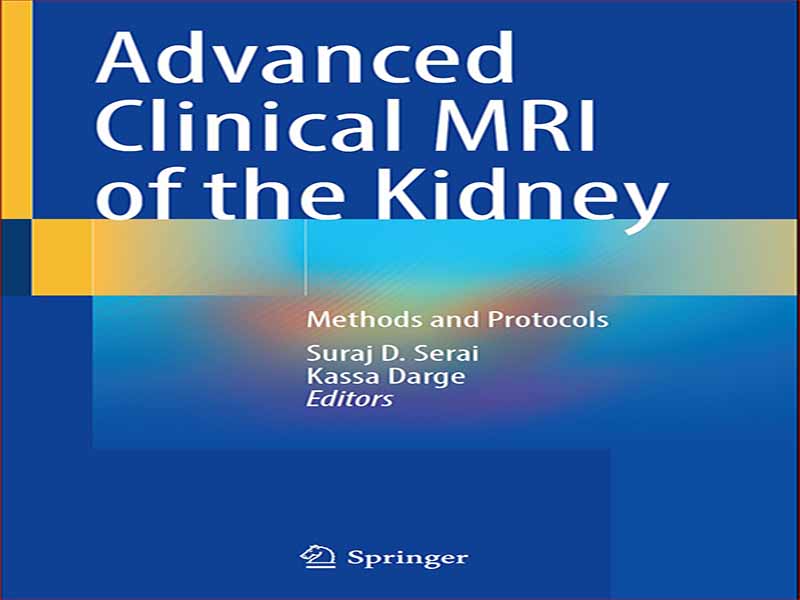- عنوان کتاب: Advanced Clinical MRI of the Kidney
- نویسنده: Suraj D. Serai
- حوزه: بیماری کلیه
- سال انتشار: 2023
- تعداد صفحه: 463
- زبان اصلی: انگلیسی
- نوع فایل: pdf
- حجم فایل: 38.1 مگابایت
تکنیکهای کمی MRI نشانگرهای امیدوارکنندهای را برای بیماری کلیوی نشان میدهند و میتوانند بینشهای بیشتری را در مورد مشخصات آسیبشناسی کلیه و پیشرفت بیماری در بیماران ارائه دهند. علاقه به نشانگرهای زیستی مشتق شده از MRI کلیه به دلیل پتانسیل کمی سازی تغییرات مورفولوژیکی، ریزساختاری، همودینامیک و متابولیک به صورت غیرتهاجمی و در کل پارانشیم کلیه است. رادیولوژیست ها به طور کلی سیگنال را با استفاده از توصیف کننده های شدت مانند “hyperintense” یا “hypointense” ارزیابی می کنند و از ظاهر سیگنال مورد انتظار بافت های مختلف و آسیب شناسی های مرتبط برای ارائه یک تشخیص افتراقی استفاده می کنند. با این حال، این تجزیه و تحلیل ذهنی از تصاویر نسبتا “وزن” تنها کسری از اطلاعات ویژگی بافت است که می تواند توسط تکنیک های MRI ارائه شود. هنگامی که بیش از یک بافت مقایسه می شود، مفهوم “وزن دادن” می تواند شروع به شکسته شدن کند. علاوه بر این، محدودیتهای فناوریهای MRI کنونی شامل دریافت متغیر تصویر از طریق اسکنرها، تکرارپذیری محدود تصاویر، و تغییرپذیری بین خوانندههای شناخته شده در تفسیر تصویر است. MRI کمی یک تجزیه و تحلیل منحصر به فرد و مجزا از پارامترهای بافتی ارائه می دهد و نویدبخش رفع برخی از این محدودیت ها است. تا به امروز، رایجترین ویژگیهای کمی MRI مورد استفاده در عمل بالینی، تصویربرداری با وزن انتشار، نگاشت کسر چربی (FF) و نقشهبرداری پرفیوژن است. با توجه به زمان اسکن قابل توجه اضافی که مورد نیاز است، کمی و نقشه برداری از زمان های آرامش T1 و T2، که بر همه سیگنال های MR تأثیر می گذارد، معمولاً انجام نمی شود. در دهه گذشته، به طور فزایندهای آشکار شده است که مقادیر بیوفیزیکی قابل اندازهگیری با MRI میتوانند کاربردی فراتر از ایجاد کنتراست تصویر داشته باشند. به طور خاص، این مقادیر بیوفیزیکی مانند T1، T2، و T2* به نوع بافت حساس هستند و باید آنها را قادر به توصیف تغییرات “در” بافت های ناشی از پیری، بیماری یا مداخله کنند. این یک فرضیه قانع کننده در زمینه پزشکی کلیه است زیرا طیف وسیعی از تکنیک های MRI به تغییرات پاتوفیزیولوژیکی مرتبط با پیشرفت بیماری کلیوی حساس است. از این نظر، MRI ممکن است منبع جدیدی از نشانگرهای زیستی غیرتهاجمی را برای اطلاع رسانی در مورد پاتوژنز، بهبود پیش بینی پیشرفت بیماری و ارزیابی اثرات درمان باز کند. این تکنیکهای کمی MR میتواند به درک عمیقتر عملکرد و ترکیب بافت کلیوی بیمار کمک کند، که میتواند ارزیابی دقیقتر و زودتر بیماری کلیوی را ارائه دهد و مداخلات اولیه را برای متوقف کردن یا کند کردن پیشرفت بیماری کلیوی تسهیل کند. علیرغم تلاش های تحقیقاتی قابل توجه و اطلاعات کمی منحصر به فرد موجود در اسکنرهای MRI بالینی، ادغام روش های کمی MRI در عمل بالینی محدود شده است. دلایل متعددی برای این وجود دارد، از جمله این واقعیت که پارامترهای اکتساب و پروتکل های تجزیه و تحلیل داده ها هنوز استاندارد نشده اند. عوامل دیگر عبارتند از پشتیبانی محدود فروشنده، مشکلات در تفسیر، “ارزش افزوده” محدود درک شده بالاتر از MRI معمولی، و عدم بازپرداخت اضافی. این کتاب برای پرداختن به برخی از این مسائل در نظر گرفته شده است. این به خواننده پایه محکمی برای درک تکنیک ها و کاربردهای بیومارکرهای کمی MRI در تصویربرداری کلیه می دهد. ما اکنون وارد عصری شدهایم که در آن میتوان اندازهگیریهای کمی سریع بسیاری از خواص فیزیولوژیکی مرتبط را به دست آورد – انتشار، پرفیوژن، محتوای چربی، محتوای آهن، سطح اکسیژن خون، کشش بافت، T1، T2، و غیره. در کاربردهای مختلف کاربرد علمی و بالینی یافته است. با پیشرفت قدرت محاسباتی اسکنرهای MRI مدرن، میتوان تصاویر را پس از پردازش و نقشههای کمی بر روی کنسول اسکنر تولید کرد و به محض اینکه تهیه کامل شد برای بررسی آماده میشود. چنین روشهای کمی MRI در تصویربرداری کلیه حیاتی هستند زیرا در مقایسه با توصیفهای کیفی نسبتاً بیطرفانه هستند.
Quantitative MRI techniques reveal promising markers for renal disease and could provide additional insights into kidney pathology characterization and disease progression in patients. The interest in renal MRI-derived biomarkers is driven by the potential to quantify morphological, microstructural, hemodynamic, and metabolic changes noninvasively and across the entire kidney parenchyma. Radiologists generally evaluate signal using intensity descriptors such as “hyperintense” or “hypointense” and use the expected signal appearance of various tissues and associated pathologies to render a differential diagnosis. However, this subjective analysis of relatively “weighted” images is only a fraction of the tissue property information that could be provided by MRI techniques. The very concept of “weighting” can start to break down when more than one tissue is being compared. In addition, limitations of current MRI technologies include variable image acquisition across scanners, limited reproducibility of images, and known inter-reader variability in image interpretation. Quantitative MRI provides a unique and discrete analysis of tissue parameters and holds promise in addressing some of these limitations. To date, the most common quantitative MRI properties used in clinical practice are diffusion-weighted imaging, fat fraction (FF) mapping, and perfusion mapping. Quantification and mapping of T1 and T2 relaxation times, which affect all MR signals, are not commonly performed given the additional significant scan time that would be required. In the past decade, it has become increasingly apparent that the biophysical quantities measurable by MRI can have a utility beyond generating image contrast. In particular, these biophysical quantities such as T1, T2, and T2* are sensitive to tissue type and should enable them to characterize changes “within” tissues caused by aging, disease, or intervention. This is a compelling hypothesis in the context of renal medicine because a range of MRI techniques is sensitive to the pathophysiological changes associated with the progression of renal disease. In that sense, MRI may open up a novel source of noninvasive biomarkers to inform about pathogenesis, improve predictions of disease progression, and evaluate treatment effects. These quantitative MR techniques could aid in a deeper understanding of the function and composition of a patient’s renal tissue, which could provide a more accurate and earlier assessment of renal disease and facilitate earlier interventions to halt or slow down renal disease progression.
Despite considerable research effort and unique quantitative information available on clinical MRI scanners, integration of quantitative MRI methods into clinical practice has been limited. There are multiple reasons for this, including the fact that acquisition parameters and data analysis protocols have not yet been standardized. Other factors are limited vendor support, difficulties in interpretation, limited perceived “added-value” above conventional MRI, and lack of additional reimbursement. This book is intended to address some of these issues. It gives the reader a solid basis for understanding both the techniques and the applications of quantitative MRI biomarkers in kidney imaging.
We have now entered an era in which it is possible to obtain rapid quantitative measurements of numerous physiologically relevant tissue properties—diffusion, perfusion, fat content, iron content, blood oxygen level, tissue elasticity, T1, T2, etc. Each property has found scientific and clinical utility in various applications. With the advancement of the computing power of modern MRI scanners, the images can be post-processed and quantitative maps be generated on the scanner console, ready for review as soon as the acquisition is complete. Such quantitative MRI methods in kidney imaging are vital because they are relatively unbiased as compared with qualitative descriptions.
این کتاب را میتوانید بصورت رایگان از لینک زیر دانلود نمایید.
Download: Advanced Clinical MRI of the Kidney




































نظرات کاربران